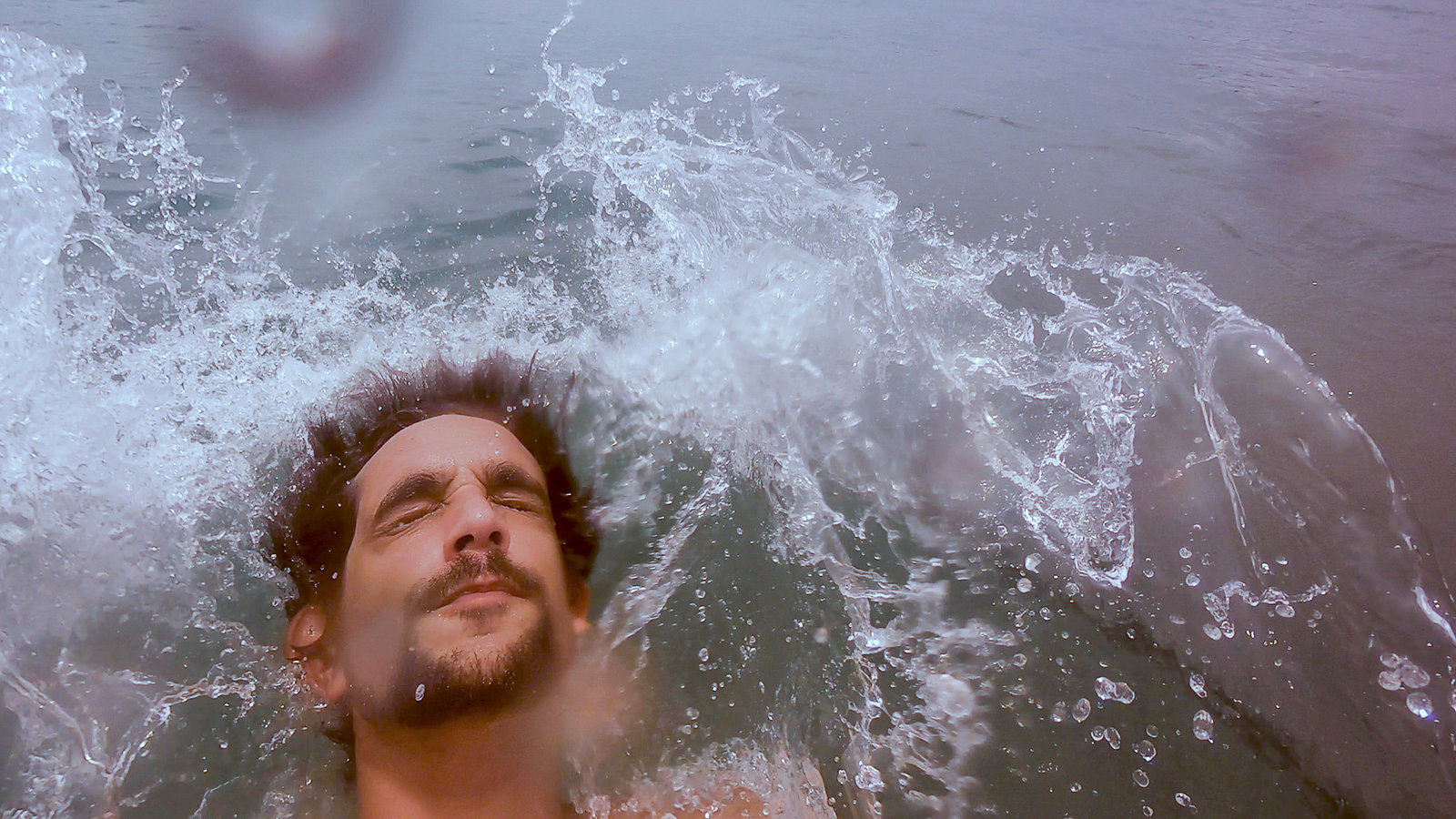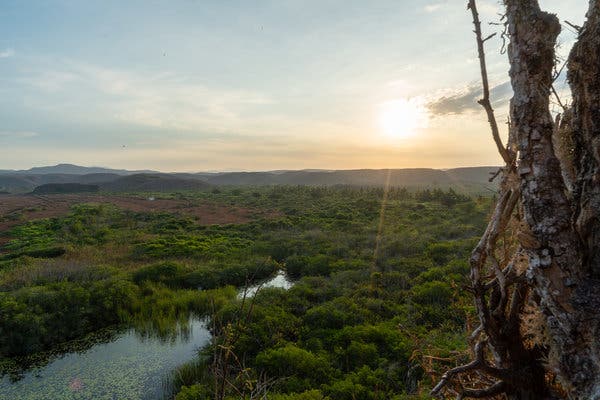
CreditCreditSebastian Modak/The New York Times
I arrived at Luís Eduardo Magalhães International Airport in Salvador, Brazil, four hours before my flight. I was headed to São Paulo where I was supposed to connect to Santiago, Chile, and then, the next morning, travel onward to the Falkland Islands, my 22nd stop of a yearlong journey. In the LATAM Airlines check-in area, I was greeted by a line longer than a Supreme sneaker drop, unmoving.
“Suckers forgot to check in online,” I thought to myself, smugly.
But no: this was the “Bag Drop” line, each glassy-eyed traveler staring into the void had a baggage tag firmly secured on their suitcases.
As ground staff scurried by, avoiding eye contact, people screamed out various things to the effect of “what the hell is going on?”
What was going on was a total meltdown. Earlier that day a power surge on the runway had shut down all operations and tragically killed an engineer working to fix it. The result for travelers? That frequent flier’s dreaded phrase: “cascading delays and cancellations.”
By the time I reached the desk, almost four hours later, to simply drop off my bag, my scheduled departure time was minutes away. I was assured the flight was delayed indefinitely and that I’d make it. All those tweets from people telling me I should never check in a bag echoed in my head.
A meltdown at Luís Eduardo Magalhães International Airport in Salvador, Brazil, forced our 52 Places Traveler to alter his itinerary.Credit
I rushed to the gate and before I could even pull out my boarding pass I could tell it was game over. About 30 other travelers stood by, looks of varied degrees of exasperation on their faces, as the gate agent explained that the plane had just left.
All of us were launched into that never-ending labyrinth of customer service calls and lines. My problem was not just that I would be late to my next destination: In Santiago, I was supposed to get on the one flight a week to the Falkland Islands, also known as Las Islas Malvinas, a remote archipelago in the South Atlantic, which was leaving in about 12 hours. It was soon clear that there was no way I would make it.
The most nightmarish travel moments reveal human emotions at their rawest. It’s so easy to cry at airports. Over a lifetime of travel, I’ve had my fair share of breakdowns on patterned carpets to the soundtrack of boarding announcements. When you think about it, the distance we can traverse with the drop of a credit card is a bit of a miracle. But despite that, to have your plans upended and not be able to get them back on track is a feeling of helplessness so overwhelming that there’s nothing else to do but find a corner and let the tears flow.
This trip has changed that for me. When being perpetually in transit becomes the norm, the detours and roadblocks become the expected turbulence along the way. It first happened in the U.K. When my train — a refurbished line that was one of the primary reasons I went to Scotland — was canceled, I found myself calmly asking when the next train might depart and if there was a nearby pub where I could pass the time. I was surprised by my reaction.
So I surprised myself again with my response to this disaster. I went back to my hotel and jumped into the rebooking fray. I replanned my itinerary to swap the order of destinations on the 52 Places list, and arranged to go to Mexico instead. Sometimes you have to cut your losses and start from scratch. The next day, I started the nonsensical route I had managed to book less than 12 hours in advance based on the available connecting flights. I would fly from Salvador to Belo Horizonte, Brazil, to catch a flight to Buenos Aires (all the time heading south, away from my target), then north to Panama City; and finally to Puerto Vallarta, Mexico. Halfway through my 40-or-so hour journey, I found myself laughing at the absurdity of it.

Puerto
Vallarta
Atlantic
Ocean
Panama City
Pacific
Ocean
Belo Horizonte
Buenos Aires
UNITED
STATES
Puerto
Vallarta
Pacific
Ocean
Mexico
City
Area of detail
COSTALEGRE
Chalacatepec
Chamela-Cuixmala
Biosphere Reserve
Pacific
Ocean
Pueblo Careyes
Barra de Navidad
TENACATITA
Manzanillo
I reminded myself that travel is a wonderful privilege, even as I wandered through airport after airport in that unique daze that results from hours spent in pressurized airplane cabins and economy class seats.

CreditSebastian Modak/The New York Times
A place to recuperate
If there’s a place to recuperate from a stressful experience, it’s Costalegre, a chain of pristine beaches in the state of Jalisco that stretches around 130 miles between Puerto Vallarta and Manzanillo.
Driving south from Puerto Vallarta, the concentration of enormous beach resorts thinned out until I found myself the only car on the road, winding through a dense jungle, turned beige from lack of rain. The punishing summer sun made air-conditioning futile, and when I pulled over, I could see the shadows of vultures circling above me.
Costalegre, a trademarked portmanteau translating to “Happy Coast,” is being heralded as a new frontier for Mexico tourism now that other beach escapes like Tulum have passed the threshold between boho secret and overrun long-weekend escape. It made the 2019 list because of a new airport and new resorts that will make it easier to get to its largely unpopulated beaches.
My drive was often interrupted by construction; a massive highway expansion is underway. I drove past the faded signs of resorts past, some being rebuilt under global brands like Four Seasons and Louis Vuitton, after successive hurricanes, including 2015’s Hurricane Patricia, flattened much of the coastline. That new airport, under construction for what locals told me felt like decades, is nearing completion in Chalacatepec, about halfway down Costalegre.
But if this is the next Riviera Maya, that’s still a ways away.
I started my tour through the region on its southern edge, in the fishing village of Barra de Navidad. A sleepy settlement that sits between the Pacific and a tranquil lagoon, its foreigner contingent is dominated by Canadian and American retirees. The town itself is a dense collection of beachside bars, restaurants and souvenir shops where, in the midday heat, shopkeepers napped with newspapers spread over their faces.
I spent one particularly swampy afternoon talking to Luis Dávila, a local historian. He regaled me with stories about this little town’s significance to history, mainly as a major shipping center in the 16th century as the Spanish empire sought to link its colonies in Latin America with those in the Philippines.
Blinking through the sweat coating my eyelashes, I asked Mr. Dávila what he thought of the rumors around heavy development in the region; what was the future of Barra de Navidad and Costalegre?
Mr. Dávila said he thinks it will be a long time before the area is transformed beyond recognition, in part because of the area’s history of unfinished development projects.
“It’s like they see a gold mine, but need another gold mine to fund it,” he said. “So I’m optimistic about the future here.”
My most ambitious expedition while in Barra de Navidad was the 20-mile trip to Tenacatita. A wide open beach, with a set of rocks at one end nicknamed “The Aquarium” for the variety of marine life that hang out in its nooks and crannies, Tenacatita has a complicated past. It was only recently cleared of private security and reopened to the public after a long and intense standoff between developers and locals. It was perhaps a sign of things to come.
To the land of the 1 percent
It was strange then, after driving through village after village, each an exercise in controlled chaos, to turn into Pueblo Careyes with its perfectly trimmed hedges and brightly colored houses.
Careyes, I quickly learned, is an invention, borne out of the eccentric mind of Gian Franco Brignone, an Italian banker who in 1968 bought this land and carved out a paradise for the ultra-elite.
That explained the pastel-colored mansions sitting at the top of cliffs, looking like the hide-outs of Bond villains and when I searched for a place to stay in Careyes, most had nightly rates in the quadruple or even quintuple digits.
I stayed in the nearby village, designed as a place to house those who worked on the exclusive resort. For about one percent of the going rate in Careyes proper, I booked a room at Casa Xochipilli, a cozy hacienda-style bed-and-breakfast down a dirt road in a corner of Pueblo Careyes. I was the only guest — the crushing heat and humidity keeping most visitors at bay until winter — and so had the entire place to myself. I spent more than a few idle hours swinging on a hammock marveling at how the sun made the house’s bright pink paint job glow like a neon light. Being on Careyes’s outskirts allowed me to feel like I had an in to the Careyes experience, without really being a part of it.
Eating dinner at one of the two restaurants in the village, my fellow diners were a stark contrast to the vacationing Mexican families I had encountered down in Barra de Navidad. Linen-clad blondes asked if the ceviche could be made gluten-, sugar- and lactose-free and I did everything I could not to gawk at how their hair remained perfectly coifed despite the humidity that had turned mine into a poorly built nest. The streets were empty at night.
If you go
-
It’s still unclear when Costalegre’s new airport will open, but it’s unlikely anytime soon. In the meantime, to access Costalegre fly into either Puerto Vallarta or Manzanillo. Some of the handful of resorts on the stretch of coastline offer transportation from the airport, but the point of going to Costalegre isn’t to sequester yourself in a resort, so you’re better off renting a car.
-
Even in the low season, I encountered many Mexican families on vacation in the region and it makes sense: Costalegre is an ideal family destination. There are beaches and swimming pools galore and attractions like La Manzanilla’s Crocodile Sanctuary, where you can get up close to dozens of American crocodiles, provide diversions if the beach ever gets boring.
-
While most of Careyes is off-limits unless you’re a guest of the very expensive resort, you can still buy a day pass to access its beautiful beaches, walking trails and wacky art installations, like the Copa del Sol, an upturned concrete bowl checkered with small windows that align with the light from the rising sun.
But the next day, I walked to the nearby beach, Playa Careyitos, and I began to see the appeal. The small, white-sand strand was empty but for a handful of people gathered under the shade of a makeshift shelter. Two jutting cliffs, each with its own mansion, sheltered the cove, making the water calm. Occasionally, a small fishing boat made landfall, and men carried out buckets of freshly caught octopus and still moving fish. After swimming for a while, I approached the group I had seen when I arrived.
They were standing around a tub that held a large hawksbill turtle. She had been scooped up by one of the residents and they were waiting for a group of scientists from Puerto Vallarta to drive down so that they could tag her with a GPS device before releasing her back into the ocean. It was a special occasion; there are thought to be fewer than 20 hawksbill turtles who make this stretch of the Pacific their home. And that’s when I learned what makes Careyes special, not only despite, but because of its weirdness.
Careyes sits at the center of the Chamela-Cuixmala Biosphere Reserve, a 50-square-mile protected area. The existence of the Costa Careyes Resort is at least part of the reason so much land remains untouched and the resort’s philanthropic arm, the Careyes Foundation, continues to run projects to engage the community in conservation: projects like turtle tagging.
As my time along Mexico’s Costalegre came to an end, all the hours I spent getting there retreated into a blur. Perhaps this was a coping mechanism to get me through my many flights ahead, or perhaps it was just the magic of the place, where the concept of time thins out until sunrise and sunset are the only two moments that matter.
Here’s what I do remember: Slurping oysters on the beach, freshly shucked by the man who foraged for them just an hour earlier; a drive just before dawn, in the company of two new friends who wanted to show me the true weirdness of Careyes as displayed in the UFO-like sculptures that dot the jungle in the resort; the hours of beachside idleness where I could almost feel each of my cells regenerating.
I’d say it was worth it.







